Introduction
Since the early 1990s, Renewable Energy Sources (RES) have widened their share in the electricity generation industry across the world due to the growing environmental concerns (Pach-Gurgul 4). The interest to increase the capacity of hydroelectricity generation through RES is highly attributable to the European Union’s target to decrease carbon emissions and facilitate renewable power production. The wind and solar power schemes have surpassed traditional electricity generation ways such as fossil and nuclear fuel schemes due to their huge potential resources. The growth of wind power is anticipated to be exponential across the world. Similarly, solar photovoltaic (PV) is another RES viewed as a possible solution to the escalating demands for clean energy. Besides, RES provides an opportunity for economic development through the production of affordable energy as well as job creation from investing in RES.
Following the bulging population and the fast rate of development, energy sources have become more scarce and expensive resulting in a power crisis within the cities. With the high demand for energy, resources such as oil, coal, and natural gas will deplete. Therefore, today there is a need for renewable sources. Wind and solar energy are the most promising sources of power. Nevertheless, the future of RES deployment in the power sector is subject to contingency, but current trends manifest huge potential for the ongoing generation to hit double figures in ten years. Based on the controversial views from various studies, this study intends to explore renewable energy generation concerning the principles of operation, features of RES, compare the wind and solar generation systems, applications, and impacts as well as their energy potentials and operational efficiencies. Even though the developed countries such as the United States recognize the benefits of renewable energy, there is a need for a rapid transition to greater use of RES.
Solar Thermal Systems
Solar energy is one of the most accessible sources of energy since it entails the sun’s radiation that reaches the earth. For instance, plants rely on solar heat to synthesize food and grow; humans use direct solar heat to dry food products and clothes. Similarly, technologically designed solar panels trap the energy of the sun to create heat for running turbines, cooking, or lighting. Solar energy entails light and heat released by the sun, in terms of electromagnetic rays. Current technology has advanced to the level of trapping this radiation and converting it into usable forms of solar power such as lighting and heating.
The principles of operation of the solar heater and solar power systems
However, solar energy can be divided into two types, thermal energy, and light energy. Solar thermal technologies include devices available in the market and they are referred to as solar thermal collectors. Solar energy turned to thermal energy can be used to heat spaces such as insides houses, heat water, or heat vessels. On the other hand, solar energy is turned into electricity through either photovoltaic devices or solar power plants. PV devices or solar cells absorb sunlight and convert it into electricity. In solar power plants, electricity is generated indirectly when the heat from solar thermal collectors is used to run turbines that generate steam that is used to run a generator.
The intensity of solar energy is determined by measuring the radiation data. Radiation data is the potential of solar energy resources available in a particular region. Active and passive solar techniques are technologies designed to utilize solar energy. These classifications are based on the means of capturing, converting, and distributing solar energy. For instance, active solar techniques utilize solar panels, turbines, and pumps to change sunlight into usable energy.
Solar collectors’ designs and working principles
A solar thermal collector gathers the sun’s energy and converts its rays into heat. The most basic and common type of solar collector is the solar panels often mounted on rooftops or open grounds for both small-scale and large-scale energy supply. A solar collector operates on the principle of changing solar energy into heat via the process of the greenhouse effect. The primary idea is that the sun rays go through a surface of the glazed glass and absorbed it into the system. Therefore, solar energy triggers the molecules in the system to produce heat. Consequently, the glazing of the glass ensures the heat remains within the system. When that heat is trapped, it can be utilized for various purposes. There are two main designs of solar collectors including flat-plate collectors and concentrating collectors.
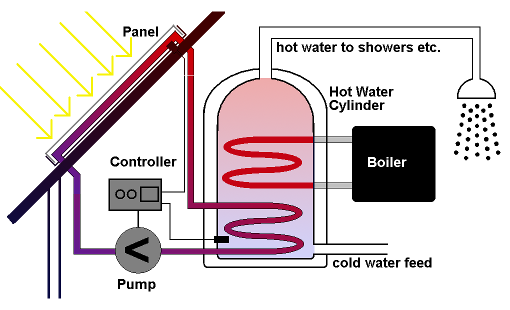
A solar panel collector is a device that is used to convert solar rays into useful energy for various domestic purposes such as heating water for domestic or industrial use. The basic principle of a solar water heater applies the three basic ways that define heat movement. These ways include radiation, conduction, and convection. Heat is defined as a type of energy related to the movement of molecules from a region of high concentration to a region of low concentration (Pach-Gurgul 5). Heat moves from regions of higher to lower temperatures until the temperatures reach equilibrium. This heat movement is determined by the difference in temperatures between objects. When the electromagnetic rays reach the surface of the solar panel through radiation, they excite the molecules of the panel system through conduction making them move. The molecular motion is defined as heat. When the temperature of the solar panel increases, the heat moves through the controller to reach cold water, which is heated through convection to attain the same temperatures as the incoming molecules.
System configurations
Figure 2 below demonstrates a schematic block diagram of the heat flow via a collector. In a bid to define its thermal performance or collector efficacy, it is essential to analyze the heat flow system in the collector. As illustrated in figure 2, part “of the radiation is reflected in the atmosphere and the rest absorbed by the glazing glass and transmitted through the system” (Wang and Wu 74). Essentially, the amount of heat generated is determined by the rate of transmission of the surface and the absorption speed of the underlying material.

When the “collector absorbs heat, its temperature exceeds that of the surrounding and heat escapes into the atmosphere by convection and radiation” (Wang and Wu 76). The pace of heat absorption or loss depends on the collector temperature or heat transfer capacity. Thus, the performance of a flat-plate collector can be maximized using materials with a high absorption rate and ensuring high variance in temperatures between the collector and the heating zone (Pach-Gurgul 5).
Wind energy
Wind power uses the natural wind and changes it into mechanical form then to electricity. The current wind turbines are an evolution of the traditional windmill used decades ago to pump water among other activities. Currently, wind power is gaining huge acceptance as a sustainable RES across the globe. Wind power generation can be categorized into onshore generation and offshore generation.
The principles of operation and features
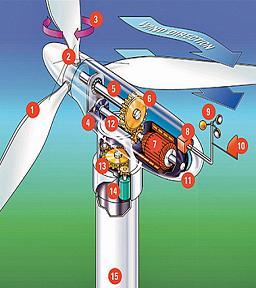
Wind power generation systems use blades to capture the wind as it blows and the energy rotates the turbines. This circular motion causes an internal shaft to spin that is interlinked to a gearbox to optimize the speed of rotation. The entire system is connected to a generator that produces electricity. The features of a wind power system include a steel tubular tower meant to offer anchorage for a hub. The hub contains wind turbine blades and housing for the turbines shaft, controls, gearbox, and generator.
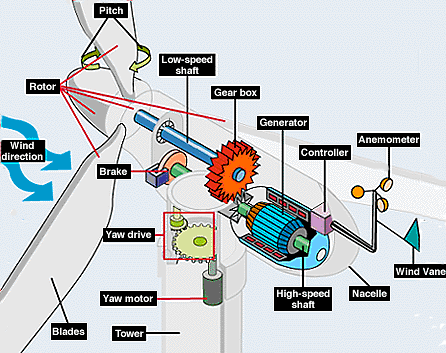
This system is the most common form of wind turbines often used for large-scale production of energy.
Pitch blade system
The basic purpose of the pitch system is to maximize power production and to halt the wind turbine during service and emergency times. The pitch system is designed to fit a certain wind turbine design in a bid to maximize the operation even under low, medium, or extreme wind situations. The Pitch blade system helps keep the rotor speed within manageable extends as the wind velocity changes (Khare, Nema, and Baredar 26).
Comparing the geared drive and direct drive systems to generators
Direct drive systems have no gears or belts but depend on large motors to initiate their motion. Direct drive systems have more ability to transmit high-frequency energy as opposed to geared turbines. Gear-driven wind turbines have many wheels and bearings fixed within the gearbox. Due to wind pressure, the gearbox suffers extreme stress and any damage in a single part can cause the turbine to stop. Geared systems are more a bit expensive and require higher costs of maintenance compared to direct-drive systems. Besides, the decreased breakdown is another factor to use direct drive systems ahead of gearboxes in wind power generation.
The characteristic performance curve
Characteristic performance curves of wind turbines are curves that help identify the behavior and performance of the turbine system under various operating conditions. These curves are plotted from the results of the findings obtained based on various parameters that include speed, power, discharge, and the inlet opening. The major curves include the constant head curve, constant speed curve, and constant efficiency curve. The constant head curve helps to calculate the overall efficiency. The head inlet is held “constant to obtain corresponding values of power for each value of speed and the constant speed curve helps find the variation in power as well as determine the minimum discharge needed to resist the friction” (Wang and Wu 76). The constant efficiency curve is necessary for determining the area of constant efficiency and predetermining the performance of turbines at various efficiencies.
Comparing on-shore wind farms with offshore wind farms
There are various advantages similar to onshore and offshore wind energy. First, this source of renewable energy does not cause pollution and global warming. Even though there are pollution costs incurred during the production and transportation of the wind equipment, the running of the wind turbines does not cause any pollution. The costs of running wind energy production are low for both offshore and onshore productions. In the production of wind energy, other sources of fuel or energy are unnecessary, which makes it one of the cleanest and cheapest sources of energy. However, there are merits of offshore wind over onshore wind energy generation.
First, no noise pollution because of the whirring sounds from the wind turbines. Offshore wind farms are situated far off the coastline and thus no noise pollution for people living around the coast. There is stronger and frequent wind turbulent in the offshore wind due to water currents. Such turbulent winds increase the capacity of energy production because the turbine motion is increased significantly. On the other hand, the cost of installing offshore wind power is high. The towers used to hold the wind turbines need to have a high tolerance to water corrosion and should be firm to withstand storms and water currents.
Energy potentials and operational efficiencies
Determining how much Solar and wind energy is a clean, renewable form of energy that needs only natural resources that can be accessed at no cost. Besides, these forms of energy are suitable in both dry and rainy parts of the world, offering economic investment to all regions. RES helps avoid various environmental effects since it does not emit greenhouse gasses. However, a wind turbine cannot convert all the wind’s energy into usable energy. Essentially, the wind has huge potential for energy and the power that can be obtained out of the wind depends on the system design and capacity.
Solar and wind energy potentials and geographical/seasonal variations
RES enables human development, particularly in the developing and dry regions. Countries with limited resources of fossil fuels and water bodies may benefit from renewable energy. Solar PV and wind power plants have been used to cater for a huge fraction of the increasing need for electricity. Geographical locations and seasonal variations are major factors to consider when installing solar and wind energy plants. For instance, countries like India are situated in the equatorial sunbelt of the earth hence obtaining plenty of electromagnetic rays from the sun. Consequently, India can access about 4500 trillion kWh of direct sun energy annually (Baltas and Dervos 359). A solar energy plant is highly reliable during summers than in winter when the days are hotter. During winter, the system will produce energy but in low amounts.
Comparing operational efficiencies of PV systems with wind generators
Photovoltaic systems are more effective and reliable because they are not prone to breakage when compared to wind turbines. PV panels have no mechanical components in motion, except when the panels are moved to tap sunlight energy. Consequently, PV has a promising future for both economic sustainability and environmental conservation. Due to their durability and consistency in operation, PV systems are more efficient in power generation. Even though such systems might not surpass the amount of energy produced by wind generators, their consistency and affordability are undisputable (Khare, Nema, and Baredar 29). On the other hand, wind generators are more reliable throughout the year because rain or clouds do not affect them. Even when the wind is calm, wind turbines use generators to propel the turbines.
Merits and demerits of solar thermal systems and wind power systems
The main advantage of solar thermal energy and wind power systems is that there is no fuel cost incurred. The absence of fuel costs is an advantage over fossil fuels whose costs are hiking at a swift rate. Second, these RES are highly predictable making it convenient for users. Solar and wind energy plants can produce power for 24 hours a day making electricity supply more consistent and reliable. Third, RES is pollution-free and no greenhouse gas effects. Unlike, the non-renewable energy source, RES does not face policy restrictions from the EU or other environmental regulatory bodies (Pach-Gurgul 7). Fourth, RES is readily affordable and cheap to maintain. Solar and wind energy plants use equipment made on a large scale at affordable prices and require minor services after long periods of operation.
Most of the common drawbacks of RES are linked to the ongoing breakthroughs in technology. The unpredictable future of technology has increased the possibility of making the current solar and wind plant equipment obsolete (Khare, Nema, and Baredar 31). RES has evolved into a hotbed of innovation with daily updates of potential advancements in materials and processes in generation technology. However, the cost of frequent replacement is a burden to the entire economy since it might lead to an increase in prices for renewable energy products. Second, setting up solar thermal plants is challenging when establishing a suitable location. They can be situated in areas that have a high amount of solar radiation, particularly in the deserts. Even though solar and wind energy can be harnessed during cloudy and calm days, the efficiency and frequency of power generation decline.
Block diagrams for off-grid and grid-tied wind power systems
A grid-tied system entails a net metering agreement and relies on an electrical utility power grid. The utility is the backup source since the extra-generated power can feedback when needed.
Section
- Wind turbine
- Charge controller
- Emergency generator
- Inverter
- Power grid
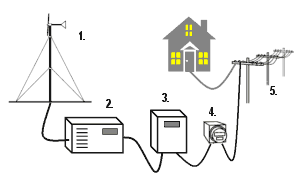
There are various types of off-grid wind energy, depending on demand and budget. The figure below shows the essential components of an off-grid system. The diagram shows a wind turbine and an optional solar panel to offer electricity to run home or industry appliances. The energy that is not used directly is stored in the battery bank for future use.
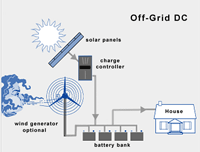
Negative implications of solar thermal systems and mitigation process
Solar thermal systems are associated with adverse environmental concerns based on the process followed to develop it and maintenance. Solar energy plant equipment is made in the industries substantially powered by non-renewable energy. Besides, the installation and maintenance use of non-renewable energy sources. The solar thermal plants need a lot of water for steam to power the generator. Water also serves as a coolant and helps clean the equipment. Therefore, newer non-water intensive techniques should be developed to work as alternative coolants. In a bid to avoid occasional replacement of solar plant equipment and reduce the environmental effects related to the production of the equipment, it is essential to ensure frequent servicing of the equipment. The motor should be lubricated frequently to avoid breakage resulting from friction (Baltas and Dervos 360). The pump should be kept away from dirt and rain.
Negative implications of wind generator systems and mitigation process
Wind generator systems negatively affect weather radars. Weather radars are used to monitor winds and rainfall as well as identify disastrous occurrences such as storms. Errors in weather radar data may occur and influence the feedback of weather forecasting. This aspect happens when wind turbines are installed in line with the sight of weather radar. This interference can cause clutter and erroneous wind predictions. Since clutters and echoes from wind turbines are unsuitable for weather radars, wind turbines should have inbuilt clutter filters to suppress echoes. Second, wind generator systems affect plants and animals because they occupy large tracts of land. These structures lead to the loss of wildlife habitats and natural vegetation. Besides, wind turbines often cause bird collisions. However, with modern turbines with minimal blade spins, birds’ collisions are expected to decline. Similarly, offshore wind plants can minimize bird collisions because few birds fly beyond the coastlines.
Conclusion
Electricity production accounts for a substantial percentage of greenhouse gas emissions. Wind and solar energy avoid various non-climate related impacts linked to fossil-fueled electricity such as effects on human health and physical injury. However, considerable reductions in emissions can be achieved through a profound shift to non-carbon resources such as RES. RES is highly expected to add a substantial part of production in power systems. However, following the increased demand for RES, achieving high levels of solar and wind electricity across the globe is inevitable. There seem to be no significant technical, policy, resource, or production barriers to attaining substantial solar and wind energy shortly. Undoubtedly, with the large unused solar and wind resource, energy generation through solar and wind posts a promising future.
Works Cited
Baltas, Evangelos, and Nikolaos Dervos. “Special framework for the spatial planning & the sustainable development of renewable energy sources.” Renewable Energy Journal 48.3 (2012): 358-363. Print.
Khare, Vikas, Savita Nema, and Prashant Baredar. “Solar–wind hybrid renewable energy system: A review.” Renewable and Sustainable Energy Reviews 58.2(2016): 23-33. Print.
Pach-Gurgul, Agnieszka. “Significance of the Climate and Energy Package for the Development of Renewable Energy Sources in the European Union.” Comparative Economic Research 17.2 (2014): 4-7. Print.
Wang, Xing, and Li Wu. “Analysis and performance of flat-plate solar collector arrays.” Solar Energy 45.2 (2010): 71-78. Print.